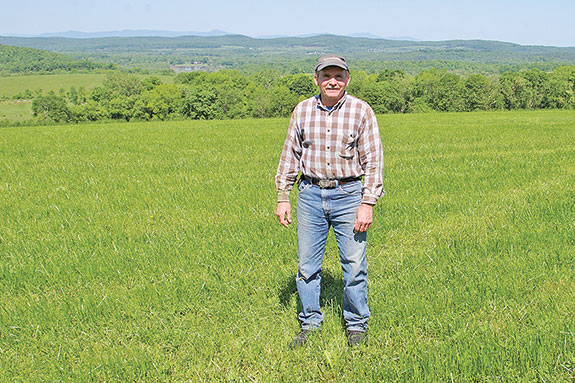It’s well known that dairy cow diets require forages in order for the rumen to function properly. Rumen microbial fermentation must occur, for the most part, in the presence of complex carbohydrates such as cellulose, hemicellulose and pectins.
These carbohydrates are found primarily in forages such as grasses and legumes.
However, as forages mature their cell walls thicken, making it more difficult for rumen microbes to penetrate through them and ferment the sugars and proteins inside the cells.
This is the main drawback forages pose when using them in large amounts in high-producing dairy cow diets.
Rumination and the production of volatile fatty acids (VFA), the precursors necessary for energy metabolism, decline when microbial fermentation is diminished due to the thickening of cell walls. The laboratory analysis of fiber is synonymous with cell wall content.
Getting milk cows to produce upwards of 100 pounds of milk on high-forage diets can be challenging – but is not impossible.
The key to high milk production on high-forage diets is focusing on hay crop forages that have low fiber (i.e. thin cell walls) content. Immature plants with thin cell walls and a minimum of lignification are more easily ruminated and are more digestible.

In Ancramdale, New York, Jim Davenport milks about 65 cows that maintain a 25,500-pound rolling herd average on a high-forage diet.
Other production statistics are: 3.67 percent fat, 2.91 percent protein, 5.75 percent other solids and 180 DIM.
Maximizing forage intakes in his cows is a prime goal of Davenport’s.
Along with BMR corn silage that is now a staple for many New York dairy diets, Davenport feeds hay crop forages that are high in protein and low in neutral-detergent fiber (NDF) grown on his property.
Davenport grows primarily tall fescue and reed canarygrasses for his hay crop forages and works diligently to keep NDF levels as close to 50 percent as possible for all cuttings all year long.
He has experimented with alfalfa over the years but finds it does not do as well as the grasses.
He keeps a close eye on temperatures and degree days, and with many years of experience behind him, can hit his goal most of the time.
In the farming business, there’s always the trade-off of quality to tonnage. Farmers are inclined to maximize yield per acre. Tonnage and high yields, of course, equate to plant maturity, which equates to lower rumen digestibility and less nutrition.
Farmers shouldn’t be focusing on how many cuttings, per se, they get off a field – they should be focusing on optimal yield combined with optimal fiber levels.
Davenport has found that compromising quality and allowing NDF levels to climb over 50 percent will cost him more milk than what he may get in extra tonnage to the acre.
He’s found that for his farm and the local growing conditions, the optimal yield per acre tends to be about 1½ tons of dry matter per acre per cutting.
This is a key concept that must be well understood when making the most out of raising your own forages.
As tempting as it is to grow your own feed to offset the rising cost of feed, forages are completely unforgiving when it comes to quality. Unless aggressively managed, homegrown forage can quickly become horse hay, and milk production will reflect it.
Davenport currently places a value of about $150 per ton (adjusted to 10 percent moisture) to his hay crops and about $210 per ton for his BMR corn silage.
These values are well below current market costs for energy and protein prices of feedstuffs that would be purchased from local feed suppliers.
He knows that forages grown correctly can not only offset increasing grain costs that continue to eat into the bottom line of all dairy farmers, but can also make a lot of milk.
A herd of cows that produces over 80 pounds of milk per cow per day, all year long, consume a lot of feed. Davenport’s herd is currently consuming an average of about 43 pounds of forage dry matter – about half and half haylage and BMR corn silage.
A base TMR is balanced for about 77 pounds of milk production and about 55 pounds of total feed dry matter consumption.
Forage accounts for over 75 percent of his total average dry matter consumption in that TMR. Higher-producing cows in the herd receive additional grain, rumen bypass fat and a DFM.
The homegrown forages which average nine cents per pound adds up to $3.87 per cow per day or about $4.55 per hundredweight (cwt) of milk – and the herd is currently grossing about $17 per cow per day in milk revenue – based on +$20 per cwt milk price (May 2013).
Cows have a limit as to how much NDF they can consume coming from forages. Research shows that they max out around 1.2 percent of bodyweight. This means a 1,500-pound to 1,600-pound Holstein can consume only 18 to 19 pounds of NDF coming from forage.
For the Davenport herd, they are consuming about 20 pounds of NDF coming from the 40 pounds of forage they consume (50 percent NDF x 40 lbs DM). This is only possible with the low NDF levels of the forages Davenport produces.
As Davenport fine-tunes his forage production, he hopes to get to a point where he can get the base TMR to 80 percent forage while supporting 80 pounds of milk production.
Forages with NDF levels testing nearer 60 percent begin to significantly limit the amount of forage cows can consume. They also become less digestible which again limits milk production potential.
As dry matter intakes from forage decline, other feedstuffs must be added to the ration to keep the cow fed – and in most cases, the cost of the diet increases.
Diets that maximize forage NDF must be managed correctly. These diets can be formulated to keep grains and supplements down in the 25 percent area while supporting around 80 pounds of milk.
Cows reaching milk peaks of over 100 pounds of milk per day must be fed the more expensive grains and supplements to maintain that level of production.
Maximizing forage consumption in dairy cow diets enables us to utilize the cow’s natural biology to meet a significant percentage of her milk production potential. The more forage you can get your cows to eat, the less grain you have to buy. PD
PHOTO 1: Close-up of the fescue about a week in the pit, testing about 20 CP and 50 NDF ... good stuff.
PHOTO 2: Jim Davenport is standing in one of his fields of recently mowed fescue. The Hudson River Valley is in the background with the Catskill Mountains in the distance. Photos courtesy of John Hibma.

-
John Hibma
- Nutritionist
- Central Connecticut Co-operative Farms Association
- Email John Hibma






